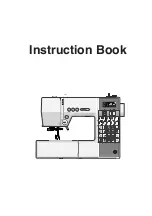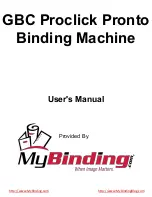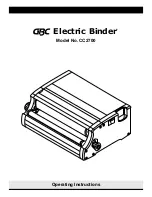
Overedging
B
A
S
I
C
S
E
R
G
I
N
G
T
E
C
H
N
I
Q
U
E
S
Seaming
Front Cover Seam Guide
Overedging to finish facings, hems and seams before construction, is one of the most basic uses of
a serger, such as making a garment or project with 5/8 inch (16mm) pressed open seams (fig.A).
To overedge, place the single layer of fabric in front of the presser foot, aligning the cut edge with
upper cutting blade. Begin serging, continuing to guide the fabric along the blade. The edge of
the fabric should be trimmed, but not cut away. Then sew the seams on your conventional sewing
machine and press them open as usual (fig.B).
Because notches would be cut away in this process, mark them before serging with "V" snips just
inside the seam allowance or with a water-soluble fabric marker (fig.C).
Note:
A 2-thread overlock or 3-thread overlock can also be used with this technique.
For garments or projects that do not require conventional pressed
open seams, you can stitch and finish the seam in one operation
and then press the seams to one side (fig.A). A 4 or 3-thread seam is
strong, yet it provides "give" or flexibility according to the needs of
the fabric.
Place two layers of fabric right sides together. Use the marks on your
serger's front cover to align the fabric for the desired seam width.
Keep your eye on the fabric edge to guide it to the appropriate mark
(fig.B).
Do not watch the needle. If you guide the fabric accurately, the
needle will seam in the correct place automatically.
Note
: For most seaming, pins are unnecessary because the serger
feeds the fabric evenly. If you need pins, place the pins parallel to
the seam line outside the seam allowance to avoid damaging the
blades.
Use the marks on your serger's front cover and set the width dial at
"M" to align the fabric for accurate seam allowances. When using the
left needle, the second mark "L" from the needle indicate 5/8 inch
(16mm) from the cutting edge to the needle.
Use the right needle, the third mark "R" from the needle to indicate
5/8 inch (16mm) from the cutting edge to the needle.
Note
: Be sure to set the width dial at the "M" setting for accurate
seam allowances.
A.
B.
C.
A.
B.
Summary of Contents for EclipseDX BLE1DX-2
Page 1: ......
Page 2: ......
Page 3: ...Congratulations on Choosing Baby Lock Eclipse dx C O N G R A T U L A T I O N S...
Page 4: ...Table of Contents T A B L E O F C O N T E N T S Front Cover Seam Guide 19 Rolled Hem...
Page 6: ...How Your Serger Operates O V E R V I E W...
Page 7: ...O V E R V I E W Overview of the Eclipse...
Page 8: ...A C C E S S O R I E S Accessories DVD U S A only...
Page 26: ...24 4 T H R E A D S E R G I N G 4 Thread Serging...
Page 33: ...31 R O L L E D E D G I N G Rolled Edging 3 Thread Rolled Edge fig A fig B fig C...
Page 34: ...32 R O L L E D E D G I N G Seaming Sheers 2 Thread Rolled Edge...
Page 44: ...42 T R O U B L E S H O O T I N G Troubleshooting...
Page 45: ...43 T R O U B L E S H O O T I N G Troubleshooting Cont Dos and Don ts...
Page 47: ...Chart for Tension Adjustment...
















































